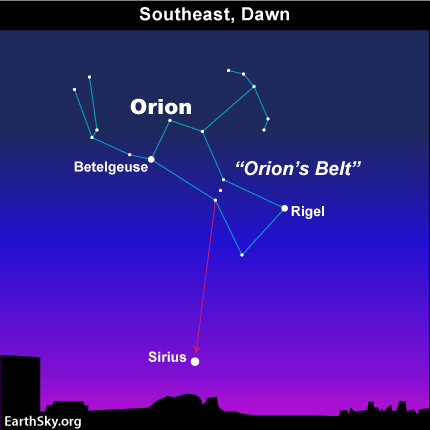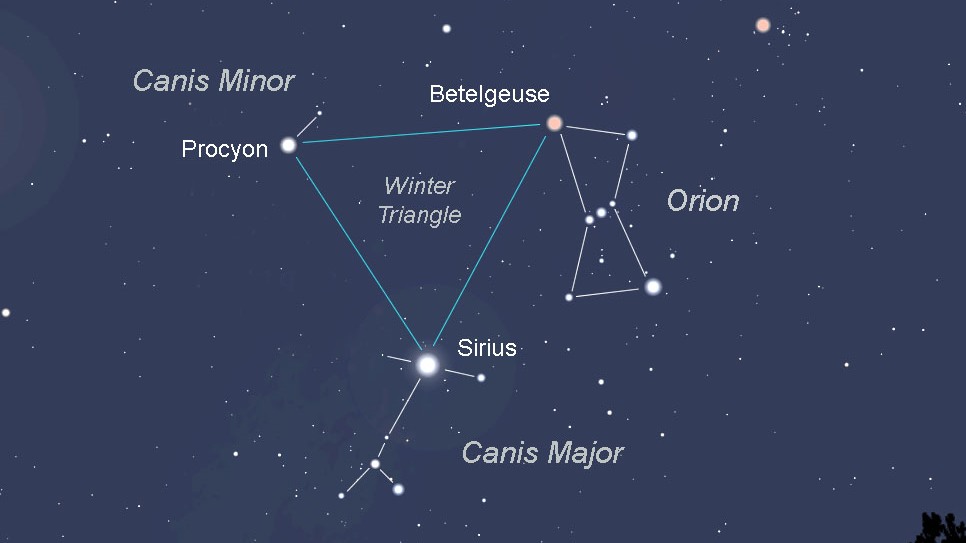Winter Constellations
Orion

Orion is possibly the most well-known constellation, apart from The Big and Little Dipper. Easily recognizable by the three bright stars that form the “belt of Orion,” the constellation is, in reality, much larger and contains several astrological features. The two brightest stars in Orion are called Betelgeuse and Rigel. Betelgeuse has a distinct red tint, which makes it easy to tell them apart. Betelgeuse may soon go completely supernova. Astronomers suspect that this supernova will not affect the Earth, but may cause a double shadow to be cast on the Earth’s surface for up to two weeks. Orion contains several celestial objects, including the Orion Nebula, De Marian’s Nebula, and the galaxy M78, which has seven known stars and many unidentified planets.
Orion is identified as the hunter by the Greeks. According to the myth, Orion was the son of the god Posiedon and Euryale, queen of the Amazons. Orion inherited his mothers talents and became the greatest hunter in the whole world. However, he boasted about this repeatedly, and was killed by a small scorpion (Scorpius), who stung him on the ankle.
Canis Major and Minor

Canis Major and Canis Minor (The Big and Little Dog) are part of the Orion family of constellations. According to Greek mythology, these two constellation represent Orion, the hunter’s faithful hunting companions. Canis Major appears to be chasing the rabbit constellation, Lepus, in the night sky.
Canis Major is home to the sky’s brightest star, Sirius, also called “The Dog Star.” Sirius is a blue star, but appears to be many different colors and has been repeatedly mistaken as a UFO. Canis Major is also home to other astrological objects, such as the Nebula known as Thor’s Helmet and the Canis Major Dwarf Galaxy. One of the most unique celestial objects in Canis Major is the colliding spiral galaxies, known as NGC 2207 and IC 2163. The larger galaxy is in the process of pulling stars and remaining material from the smaller galaxy.
Canis Minor, the much small constellation, is still easy to see because of its bright star Procyon, another binary star.
Sirius, from Canis Major, Procyon, from Canis Minor, and Beetelgeuse, from Orion, form what is known as The Winter Triangle.
The Pleiades

Also called “The Seven Sisters,” The Pleiades is a star cluster that is easy to see without any visual enhancement. It is suspected that this cluster has over 3,000 stars, even though only seven are visible with the naked eye. There is a faint nebula surrounding this cluster, known as the Maia Nebula.
The name comes from Greek Mythology. The Pleiades were the seven daughters of the nymph, Pleione, and the titian, Atlas.
Gemini
Another Zodiac constellation, Gemini, the twins, represents those born from May 21 to June 21. Gemini is easy to spot, relative to the constellation Orion. The two bright stars in Gemini, called Castor and Pollux, represent the heads of the two twins, and are bright enough to see in most lights. Pollux is the brighter of the two stars

Within Gemini, there are several deep space objects, specifically, The Eskimo Nebula, The Medusa Nebula and Geminga, a neutron star. Neutron stars are small, densely packed stars made from neutron particles. They are sometimes created in the aftermath of a supernova, when the star is not massive enough to become a black hole. A neutron star is about the size of a city, but has a mass 1.4 times the mass of our sun.
Castor and Pollux were twin brothers in Greek Mythology. Even though Pollux was the son of Zeus, which made him immortal, he and Castor were best friends. During the Trojan War, Castor was killed in battle. Overcome with grief, Pollux begged his father to take away his immortality, and so Zeus placed the two brothers in the sky together, where they could be forever.
To read more about these constellations and get the latest update on astronomical news, visit EarthSky.
Download a PDF Version of this information
